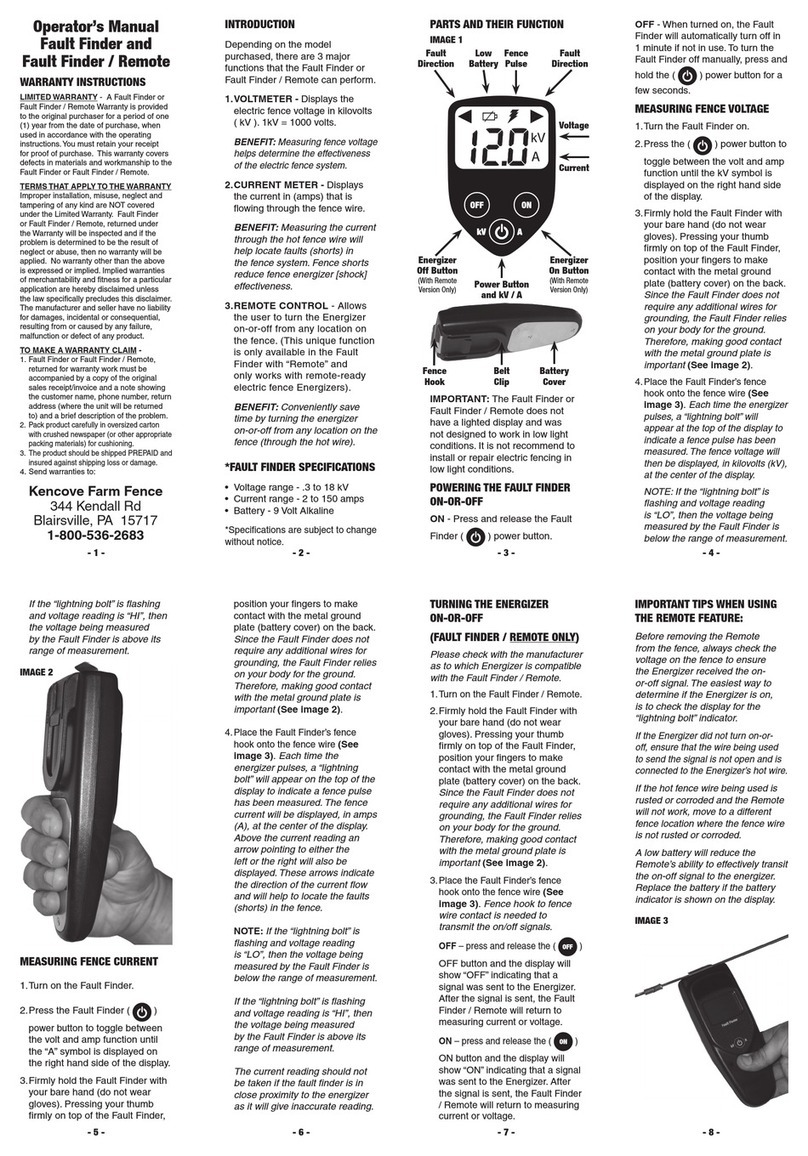
Problems
The most common cause of problems with the VPK is a dead or poor-quality
battery. If your Fault Finder fails to operate, shows no readings, or shows strange
symbols on the display, check the battery. If you don't have a battery tester or
meter, use a new (heavy-duty or alkaline battery and see if the problem
disappears (also see "Checking and Replacing Battery").
Warranty
This Fault Finder is covered by a one-year warranty against defective parts
(excluding batteries and workmanship.
If you have any operational problems, difficulties, etc., call or email your questions
or comments to Kencove Farm Fence Supplies.
Phone: 1-800-KENCOVE
Fax: 888-908-5353
Website: www.kencove.com
The Fault Finder and Voltmeter complies with AS/NZS 2064 Group 1 Class B, FCC
Part 15, EN55011, EN50082-1.
Important Notes
•Use for testing agricultural electric fences only. Attempting to measure
other high voltages could be extremely dangerous.
•The case is waterproof. Condensation can appear inside with large
changes in temperature or pressure. If so, open the case and allow it to
dry.
•To clean, simply wipe with a damp cloth.
•Do not open the unit or touch the battery while the VPK is connected to an
electric fence. You may damage the unit and receive a shock.
•DO NOT leave a dead battery in the VPK Fault Finder.
1. To check the battery, press the power button. A decimal place should
appear on the left hand side of the display. If no decimal place appears
or the battery symbol remains on the display, replace the battery.
2. To replace the battery, unscrew the four large screws from the back of
the Fault Finder. Lift the back carefully as the O-ring may stick. Remove
the old battery, and insert the new battery into position. Be sure to
match ’+’ to ’+’ and ’-’ to ’-’. The VPK uses a standard 9-volt
battery.
Kencove
VPK Fault Finder
& Voltmeter
Specifications
Voltage: 0.2 to 9.9KV (peak +/-10%
Current: 1-30 Amps (peak
User Manual
Introduction
The Kencove VPK Fault Finder and Voltmeter is the most
technologically advanced electric fence fault finder available. It
features microprocessor and surface mount technologies to make it the
easiest to use and most effective electric fence fault finding device ever
made.
This Fault Finder is able to show the current voltage, current
amperage, and direction to the fault in all electric fences, regardless of
energizer and faults. The VPK needs no second (ground connection
to read fence voltage, as it uses the capacitance of the user's hand
(nothing is felt .
Chec ing and Replacing Battery
The VPK comes with a 9-volt battery. To check or change
the battery, follow the instructions below.
Manufactured for Kencove Farm Fence Supplies by Pakton Technologies




















